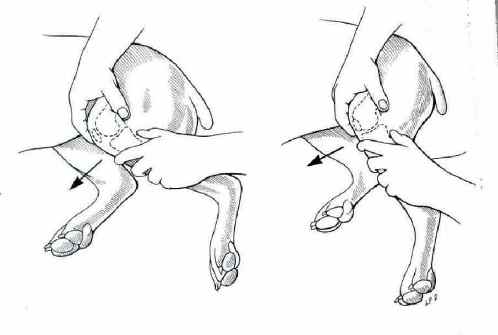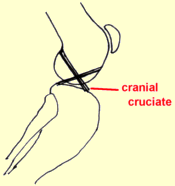If it is suspected that your dog has a cranial cruciate ligament tear or rupture, your veterinarian will perform a physical exam to determine whether or not this type of injury can be ruled out. This test involves manual manipulation of the knee joint and is referred to as the drawer test. Most dogs do not need to be sedated to complete this exam, but you will need to be the judge in determining whether or not this is necessary – if your dog’s joint is particularly painful or they do not have a great track record for excellent behavior at the vet, you may want to consider giving them sedation in order to complete the exam. A normal stifle will not exhibit a positive drawer sign, making a positive drawer an absolute indicator for CCL damage.
During the drawer test the veterinarian with stabilize your dog’s femur with one hand while manipulating the tibia with the other. If the tibia moves forward, known as a positive drawer because of the way the bone moves similar to a drawer being opened, the ligament is ruptured. If the rupture occurred some time ago, there will be swelling on the side of the leg that faces the other leg – this phenomenon is known as a medial buttress and is indicative of arthritis. The presence of a medial buttress, coupled with your dog’s state – if they are anxious or tense – can make it difficult to obtain an accurate drawer sign. Tense muscles can act as false stabilization of the knee, preventing demonstration of the drawer sign upon manipulation; sedation is indicated in these cases.
Another test, similar to the eliciting the drawer sign, is the tibial compression test. During this exam your veterinary physician will stabilize the dog’s femur with one hand, while flexing the ankle with the other. In dogs with a ruptured cranial cruciate ligament, the tibia will display forward motion upon flexion of the ankle joint. This is another way to determine whether or not your dog has a positive drawer.
Your pet’s doctor will take the results from the drawer sign test into consideration when determining a treatment plan for your dog. A negative drawer sign does not necessarily mean your canine does not have a cranial cruciate injury, and the only way to be absolutely sure of injury in the absence of a positive drawer is to have an ultrasound performed; unfortunately not many vets offer this service.
Source:
ncbi.nlm.nih.gov/pmc/articles/PMC339306/ – Diagnosing rupture of the cranial cruciate ligament


[…] sign test is an indication of a torn CCL or canine/cranial cruciate ligament. Click here – Drawer Sign Test – for more information on how a veterinarian can determine whether your dog has a torn knee […]
I’m an aspiring veterinary tech, having recently completed a veterinary health tech program, & found this info informative & helpful.
[…] with at the time (in New Mexico) thought it was minor, and couldn’t detect any kind of forward knee draw (= the classic test for torn […]
[…] During the drawer test the veterinarian with stabilize your dog’s femur (thigh bone) with one hand while manipulating the tibia (shin bone) with the other. If the tibia moves forward, known as a positive drawer because of the way the bone moves similar to a drawer being opened, the ligament is ruptured. (Source: DogKneeInjury.com) […]